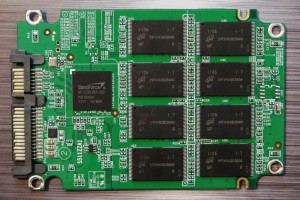FORCE SERIES 3 INTERIOR
The SandForce SF-2281 processor is on the front of the Corsair Force Series 3 SSD printed circuit board (PCB) along with the SATA 3 interface which allows connecting the drive to your laptop or desktop computer.

 Eight modules of Micron 25nm asynchronous NAND flash memory are located on each side of the PCB, each with a total capacity of 8GB for 128GB RAW capacity. One module is dedicated to firmware and over provisioning which reduces the SSD to its advertised size of 120GB and formatting further reduces total available capacity to 112GB for consumer use.
Eight modules of Micron 25nm asynchronous NAND flash memory are located on each side of the PCB, each with a total capacity of 8GB for 128GB RAW capacity. One module is dedicated to firmware and over provisioning which reduces the SSD to its advertised size of 120GB and formatting further reduces total available capacity to 112GB for consumer use.
SandForce firmware encompasses such things as their DuraClass and DuraWrite Technologies which increase the lifespan and performance of the drive but the typical consumer is never shown just how advanced technology has become. Wear leveling, for instance, provides a mechanism by which the SSD is able to monitor the number of times each cell has been written to and store data equally to ensure all cells wear evenly.
Just as amazing is what occurs should a cell or block go bad which is very different than what occurs with a hard drive. If an area of storage becomes corrupt on a hard drive, chances are that the data will be lost, capacity will be reduced and performance will suffer. If the same occurs on a SandForce SSD, the user will never have a clue as capacity does not change whatsoever, there is no performance hit and the data is most likely safe. In such cases, the drive recognizes that a cell or block has gone bad, shuts down the affected cells and remaps equal capacity from the over provisioning to available user capacity.
TEST BENCH AND PROTOCOL
 We have to apologize up front because our Test Bench is going through a bit of a transition but we thought it beneficial to throw in a picture in any case. A simple click will enlarge it to assist.
We have to apologize up front because our Test Bench is going through a bit of a transition but we thought it beneficial to throw in a picture in any case. A simple click will enlarge it to assist.
Our main goal in testing is to ensure that all test results are as accurate as they can be and no anomalies slip through.
We conduct all tests three times and, if necessary, we may conduct specific tests in Windows 7 ‘safe mode’ to ensure the OS has little to no influence on the end result.
We prefer to use as many benchmark programs as possible to assist with confirmation of results and provide the reader with the actual tests as received to avoid any confusion when unexpected test benchmarks are received.
SSD COMPRESSION AND TESTING FLUCTUATIONS
All SSDs are not created equal and many new SSD enthusiasts realize that when they test their new drive to confirm specifications and ensure all is in order. SandForce controlled SSDs, as in the Corsair Force Series 3 we are testing today, use compression techniques in storage whereas many others do not. This creates a bit of confusion when enthusiasts test the drive with random data through benchmarking programs such as AS SSD and Crystal Diskmark (random data sample). The results seem to be lower than the listed specifications.
The results actually present a false portrayal of the drives ability when compared to other drives such as Samsung, Crucial or Intel. It is for this reason that all of our comparison testing is done through PCMark Vantage. PCMark Vantage HDD Suite simply provides evaluation results based on transfer speeds reached through typical user patterns. Vantage provides a better testing medium, in that, it sees through the typical synthetic benchmarks and provides us with ‘true to life’ results of the drive.
BENCHMARK SOFTWARE
Software used for testing by The SSD Review consists of Crystal DiskMark, HDTune Pro, ATTO Benchmark, IOMeter along with FutureMark PCMark Vantage. We are going to give you a bit of a treat as well by giving you a peak of new software that we are presently Beta testing called Anvil Storage Utilities Professional Edition.
All do a great job of showing us the numbers that we want to see, or dont want to see in some cases, while PCMark Vantage x64 is an excellent program which recreates tests that mimic the average users activity, all the while providing a medium to measure each.
Pg1 – Understanding Todays SATA 3 SSDs & Introduction
Pg2 – Interior Components & Test Protocol
Pg3 – ATTO, Crystal DiskMark & AS SSD
Pg4 – Anvil Storage Utilities and IOMeter
Pg5 – HDTune Pro Testing
 The SSD Review The Worlds Dedicated SSD Education and Review Resource |
The SSD Review The Worlds Dedicated SSD Education and Review Resource | 